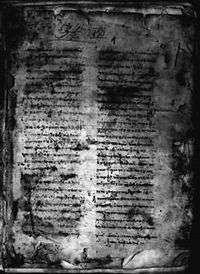Minuscule 1187
Minuscule 1187 (in the Gregory-Aland numbering), ε 1083 (von Soden),[1][2] is an 11th-century Greek minuscule manuscript of the New Testament on parchment. It has marginalia. The manuscript has survived in complete condition. It is housed in the Saint Catherine's Monastery.
| New Testament manuscript | |
 Folio 1 recto | |
| Text | Gospels |
|---|---|
| Date | 11th century |
| Script | Greek |
| Now at | Saint Catherine's Monastery |
| Size | 23.5 cm by 18.5 cm |
| Type | Byzantine |
| Category | V |
| Note | marginalia |
Description
The codex contains complete text of the four Gospels, on 307 parchment leaves (size 23.5 cm by 18.5 cm), without any lacuna.[3] The text is written in two columns per page, 25 lines per page.[3][4]
The text of the Gospels is divided according to the κεφαλαια (chapters), whose numbers are given at the margin, and their τιτλοι (titles of chapters) at the top of the pages. It has subscriptions at the end of each Gospel, with so called Jerusalem Colophon.[5][6] According to Hermann von Soden the manuscript was prepared for liturgical reading.[2]
It contains some scholia from Epiphanius of Salamis and John Chrysostom.[5]
Text
The Greek text of the codex is a representative of the Byzantine. Hermann von Soden classified it to the textual family Ir.[7] Kurt Aland placed it in Category V.[8]
According to the Claremont Profile Method it represents Λ group in Luke 1, Luke 10, and Luke 20. The leading manuscript of this group is Codex Tischendorfianus III.[7]
The text of the Pericope Adulterae (John 7:53-8:11) is marked at the margin by an obelus (÷) as doubtful.[5][9]
History
According to Victor Gardthausen it was written in the 10th or 11th century. Kondakov dated it to the 12th or 13th century.[9] Currently the manuscript is dated by the INTF to the 11th century.[4] Of the history of the codex 1187 nothing is known until the year 1886, when it was seen by Victor Gardthausen, German palaeographer. Gardthausen was first western scholar, who described the codex.[5] The first facsimile of the codex was published by William Hatch in 1932.[10]
The manuscript was added to the list of New Testament manuscripts by Gregory (as 1187e) on the basis of Gardthausen's description.[5] It was not on the Scrivener's list, but it was added to his list by Edward Miller in the 4th edition of A Plain Introduction to the Criticism of the New Testament.[11]
It is not cited in critical editions of the Greek New Testament (UBS4,[12] NA28[13]).
The manuscript is housed at the Saint Catherine's Monastery (Gr. 150), in Sinai Peninsula.[3][4]
References
- Gregory, Caspar René (1908). Die griechischen Handschriften des Neuen Testament. Leipzig: J. C. Hinrichs'sche Buchhandlung. p. 86.
- Soden, von, Hermann (1902). Die Schriften des neuen Testaments, in ihrer ältesten erreichbaren Textgestalt / hergestellt auf Grund ihrer Textgeschichte. 1. Berlin: Verlag von Alexander Duncker. p. 137.
- Aland, Kurt; M. Welte; B. Köster; K. Junack (1994). Kurzgefasste Liste der griechischen Handschriften des Neues Testaments. Berlin, New York: Walter de Gruyter. p. 115. ISBN 3-11-011986-2.
- "Liste Handschriften". Münster: Institute for New Testament Textual Research. Retrieved 8 April 2012.
- Gregory, Caspar René (1900). Textkritik des Neuen Testaments. 1. Leipzig: J.C. Hinrichs. p. 245.
- Cf. K. Lake, On the Italian Origin of Codex Bezae, Journal of Theological Studies, Vol. I, No. 3 (April, 1900), p. 445
- Wisse, Frederik (1982). The Profile Method for the Classification and Evaluation of Manuscript Evidence, as Applied to the Continuous Greek Text of the Gospel of Luke. Grand Rapids: William B. Eerdmans Publishing Company. p. 72. ISBN 0-8028-1918-4.
- Aland, Kurt; Aland, Barbara (1995). The Text of the New Testament: An Introduction to the Critical Editions and to the Theory and Practice of Modern Textual Criticism. Erroll F. Rhodes (trans.). Grand Rapids: William B. Eerdmans Publishing Company. p. 139. ISBN 978-0-8028-4098-1.
- Victor Gardthausen (1886). Catalogus codicum Graecorum Sinaiticorum. Oxford. p. 28.
- W. Hatch, The Greek Manuscripts of the New Testament at Mount Sinai: Facsimiles and Descriptions (Paris 1932), p. 27.
- Scrivener, Frederick Henry Ambrose; Edward Miller (1894). A Plain Introduction to the Criticism of the New Testament. 1 (4 ed.). London: George Bell & Sons. p. 280.
- Aland, B.; Aland, K.; Karavidopoulos, J.; Martini, C. M.; Metzger, B.; Wikgren, A. (1993). The Greek New Testament (4 ed.). Stuttgart: United Bible Societies. p. 18*. ISBN 978-3-438-05110-3.
- Nestle, Eberhard; Nestle, Erwin; Aland, B.; Aland, K; Karavidopoulos, J.; Martini, C. M.; Metzger, B. M. (2001). Novum Testamentum Graece (27 ed.). Stuttgart: Deutsche Bibelgesellschaft. p. 812. ISBN 978-3-438-05100-4.
Further reading
- Victor Gardthausen (1886). Catalogus codicum Graecorum Sinaiticorum. Oxford: E Typographeo Clarendoniano. p. 28.
External links
- "Liste Handschriften". Münster: Institute for New Testament Textual Research. Retrieved 8 April 2013.